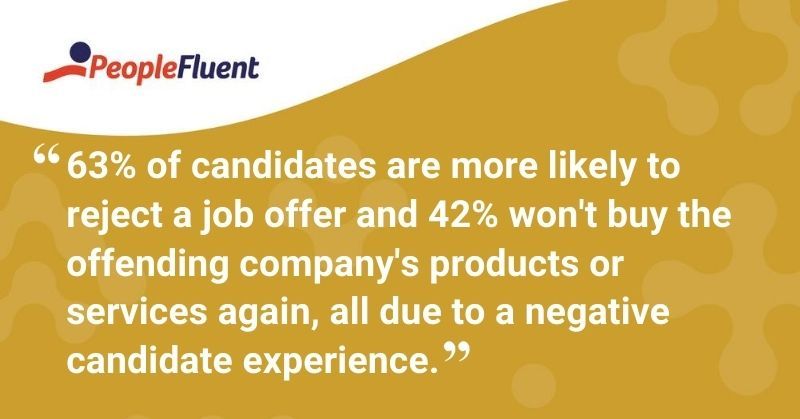Published: Jul 27, 2020Time to read: 5mins Category: Insights
Increase Hiring Efficiency With These 4 Best Practices
Creating the right hiring workflows can fast-track your most qualified candidates and recruiters to more effectively reach their hiring targets. We’ve compiled insights from the recent PeopleFluent webinar, ‘Best Practice Series: Recruitment Workflows (The Simple and The Complex)’, to help HR leaders identify key metrics to increase hiring efficiency.
According to a survey published by McKinsey, just 57% of respondents say their organizations are beginning to automate one or more business functions. When it comes to HR, recruiters can successfully manage tasks, like candidate sourcing, with talent acquisition software.
In order to help recruiters bring value to an organization, better and quicker, HR leaders must ensure their hiring managers and recruiters have the tools and information necessary to streamline and accelerate the candidate experience. To help guide this process, consider the following four best practices to increase hiring efficiency.
You might also like: ‘Talent Acquisition Triple Play: 3 Elements of a Successful Recruiting Strategy’
1) Streamline the Candidate Application Experience
Without the proper visibility into your organization’s current candidate application process, companies risk losing out on qualified talent—or worse—damaging their reputation. In fact, insights compiled by Software Advice show that 63% of candidates are more likely to reject a job offer and 42% won’t buy the offending company’s products or services again, all due to a negative candidate experience.
By auditing your current employee experience, HR professionals can improve and streamline the candidate experience by taking the necessary steps, such as:
Gathering the necessary information upfront to pre-screen your candidate list. Creating a short pre-screen application and making it easier for candidates to upload documents (like certifications or licenses, portfolio items, etc) is a great way to ensure recruiters receive the most qualified candidates. Having a detailed and quick pre-screening process is also an efficient approach to managing your potential candidates’ expectations and/or keeping them warm for future roles. The quicker a recruiter can move people through the process, the better.
Ensuring the application process is as mobile-friendly as possible. Imagine a candidate is browsing your career site from their mobile phone and feels the role is a good fit for them, only to be met with a sub-par, unfriendly mobile experience. According to Glassdoor research, mobile job seekers complete 53% fewer applications and take 80% longer to complete each application. Not only does this hinder candidates who rely on their phones to search for jobs, it leaves them with a negative impression about your organization.

Keep reading: ‘How COVID-19 Has and Will Change Recruiting Strategies’
2) Engage Candidates With Continuous Communication
Information from a CareerBuilder survey showed that 81% of candidates said continuous communication and updates throughout the hiring process would greatly improve their experience. When it comes to meeting this expectation and keeping candidates engaged, organizations can fix the process by creating automated updates as well as text, phone, and email communications.
A few quick tips:
- Send a ‘thank you’ acknowledgement to candidates after they submit their application.
- Notify candidates in a timely manner when they’ve been disqualified from further consideration.
- Notify candidates as they progress through the application process. Ensuring candidates are notified of possible next steps can help to properly manage expectations.
Handpicked for you: ‘5 Steps to Transform Your Talent Pipeline’
3) Automate Assessments and Background Checks
Moving candidates through the hiring process should be as quick and seamless as possible. By automating the required assessments (like aptitude or personality assessments) and/or background checks, hiring managers can focus on other critical tasks without getting bogged down.
Other tasks that can be automated are:
- Reference checks
- Additional requests for information to facilitate background checks
- Certification numbers or documents
- Anything else not picked up in the initial application process
- Budgetary or requisition approvals needed before sending candidate offers

More from the blog: ‘Preparing Employees to Run on Your Fast Track: 10 Onboarding Best Practices’
4) Automate Onboarding and Learning Efforts
While some onboarding programs will need to be handled in-person (like fingerprinting or obtaining building access/parking badges, etc) or via video communication, most other tasks can be automated. Learning is also a big part of a successful onboarding and pre-onboarding process. The faster a new hire can get trained on your organization’s security and safety policies, the faster they can begin bringing value to the company.
To make the process easier:
Be sure to compile any first-day documentation that can be accepted through electronic media, e.g. payroll and tax documentation, certification forms, acknowledgement of policies and procedures.
Incorporate any advanced learning to ensure you’re keeping the new hire engaged. These initiatives can include standard workplace policies around safety and or sexual harassment policies, diversity and inclusion, or other company-specific training—with considerations for global and domestic organizations.
To learn more about how to increase hiring efficiency and accelerate your company’s recruiting functions via automation, listen to a recording of the webinar and be sure to download the PeopleFluent Recruiting product sheet.
Discover How Recruitment Lets You Find the Right People—Fast
PeopleFluent helps you fill critical roles with the right people and the right skillsets on a global scale. At the same time, it helps you build your employer brand and sharpen your competitive edge.